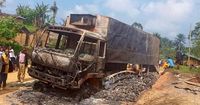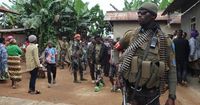On the night of September 8, 2025, the village of Ntoyo in North Kivu province, eastern Democratic Republic of Congo, became the scene of one of the deadliest massacres in recent memory. According to a chorus of local officials and international news agencies such as Reuters and AFP, members of the Allied Democratic Forces (ADF) – a group now notorious for its affiliation with the Islamic State – descended on a funeral gathering armed with machetes and guns. By the time the carnage ended, at least 61 civilians lay dead, with some reports putting the number as high as 71. The final toll may yet rise, as authorities continue the grim search for missing villagers.
“The victims were caught off guard at a mourning ceremony in the village of Ntoyo at around 9 p.m., and most of them were killed with machetes,” confirmed Macaire Sivikunula, a local administrator, in a statement to Reuters. He added that the search for both victims and attackers was ongoing. Colonel Alain Kiwewa, the military administrator for Lubero territory, told The Associated Press, “The ADF attack caused around 60 deaths, but the final toll will be given later this evening because the territory has just deployed services to the area to count the number of beheaded people.”
Eyewitness accounts paint a horrific picture. “There were about 10 of them. I saw machetes. They told people to gather in one place and started cutting them. I listened to people screaming and I fainted,” a survivor recounted to an AP journalist at a burial service the following day. Local civil society leader Samuel Kagheni corroborated that the assailants not only used machetes but also shot some victims before setting fire to vehicles and, according to reports by the U.S.-based SITE Intelligence Group, approximately 30 houses.
It was not the first time the ADF had unleashed such violence. The group, which began as an Islamist militia in Uganda in the mid-1990s, has been based in the forests of Congo since the late 1990s. Its brutality has only escalated since pledging allegiance to the Islamic State in 2018. The U.S. State Department designated the ADF as a foreign terrorist organization in 2021, citing its repeated atrocities against civilians and security forces alike. Experts estimate the group’s strength at between 1,000 and 2,000 fighters, including some from outside Congo and Uganda.
Monday night’s massacre is part of a grim pattern. According to regional officials cited by CBS News, two ADF attacks just last month left 52 people dead, including eight women and two children. And in July, the group killed 38 worshippers in an attack on a church. The United Nations mission in Congo, known as MONUSCO, has repeatedly condemned the attacks. Bintou Keita, MONUSCO’s head, said in a statement last month, “Attacks targeting civilians … are intolerable and constitute serious violations of international humanitarian law and human rights.” In response, MONUSCO has reinforced its military positions in the region, but the violence continues unabated.
The SITE Intelligence Group reported that the ADF, also known as Islamic State Central Africa Province (ISCAP), claimed responsibility for the Ntoyo massacre, boasting that they had killed nearly 100 Christians. While Congolese authorities have not confirmed this figure, the chilling message underscores the group’s intent to sow terror and division. The attack was not isolated: on the same day, officials reported that 18 more people were killed in a separate suspected ADF assault on another village in the region.
The eastern Congo region has long been a cauldron of violence, with more than 120 armed militias operating and competing for control of its vast mineral wealth. The ADF stands out as one of the most brutal, but it is not alone. Earlier this year, M23 rebels, believed to be backed by neighboring Rwanda, staged a major advance, seizing key cities and valuable mineral mines. The situation is so dire that, as Reuters and CBS News both report, former U.S. President Donald Trump’s administration stepped in to try to broker peace between Congo and Rwanda. However, any deal remains elusive, and the cycle of violence continues.
For the people of Ntoyo, the aftermath of the massacre has been marked by fear and flight. “Congolese soldiers had arrived at the scene on Tuesday morning and that many people were trying to leave the area,” said Alain Kahindo Kinama, a resident, to Reuters. Lieutenant Marc Elongo, a spokesperson for the Congolese army, admitted that by the time soldiers intervened, the ADF militants had “already committed the massacre.” The army, along with Ugandan forces, has vowed to intensify operations against the ADF, but their efforts have so far failed to stem the bloodshed.
The roots of the ADF’s violence are tangled in the region’s troubled history. Originally formed in Uganda to oppose the government, the group was forced into Congo’s dense forests, where it found fertile ground for recruitment and expansion. Its alliance with the Islamic State has given it not only a new ideological banner but also access to resources and tactics that have made its attacks even more deadly. The group’s strategy often involves targeting vulnerable gatherings—funerals, churches, and villages—where it can inflict maximum harm and terror with minimal resistance.
The humanitarian consequences are staggering. The United Nations and aid organizations warn that repeated attacks have displaced thousands, deepening the misery of a population already battered by poverty and neglect. Eastern Congo’s mineral riches—gold, coltan, and more—have brought little benefit to local communities, instead fueling the ambitions of armed groups and drawing in foreign interests. The violence has also complicated efforts to deliver aid and maintain even a semblance of normal life.
As night falls again over Ntoyo and surrounding villages, the fear of another attack hangs heavy in the air. The Congolese government, the United Nations, and neighboring countries all face the daunting task of restoring security to a region where impunity and violence have become the norm. For now, the survivors of Monday night’s massacre can do little but mourn their dead and hope that the world does not look away.
In the wake of this latest tragedy, the urgent need for coordinated international action—and for justice for the victims—has never been clearer.


